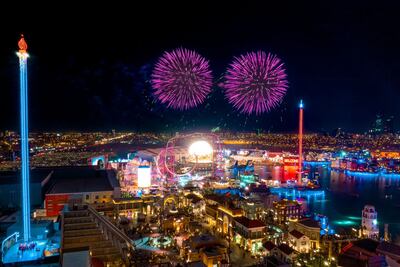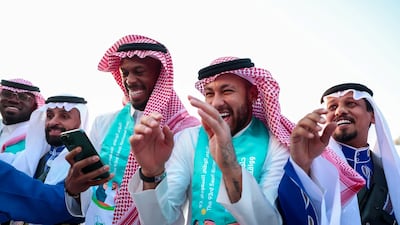“Ahlan wa sahlan [welcome], nawartina [pleased to have you in] Riyadh.”
The greeting to tourists at Riyadh airport comes from two young Saudi men working as hospitality agents, one wearing a thobe and shimag – the traditional white robe and red-and-white-checked head covering – and the other in Yeezys, cargo pants and T-shirt with a map of Saudi Arabia on it.
It's a fair representation of youth in Saudi Arabia today – strongly rooted in their own culture while embracing others.
It is also a sign of the transformation in the kingdom since Crown Prince Mohammed bin Salman, 38, launched Saudi Arabia's Vision 2030 plan six years ago, ushering in a new era not just for the economy but for the mostly young population. Saudis now are choosing to stay in the kingdom as opposed to going abroad – a dramatic shift in attitude and thinking.
The change is reflected on the streets of the Saudi capital as well. Outside Riyadh's airport, a group of Saudi and foreign football players are waiting for their cars – a reminder that this is the city that stars such as Cristiano Ronaldo and Neymar now call home.
Along with international football stars, luxury brands, international businesses and restaurants have all set up base in Riyadh.
The city of nearly eight million people is not just the kingdom's financial centre, it is also a major leisure hub. Preparations are under way for the fourth edition of Riyadh Season – a five-month celebration of art, luxury and entertainment events that kicks off later this month.
Celebrity sightings are becoming the norm in the kingdom as it draws increasing numbers of tourists – one of the goals of Vision 2030. Saudi Arabia attracted 16.5 million visitors from abroad last year.
Riyadh hosted an event to mark the United Nations World Tourism Day on September 27 at which Hollywood actor Winston Duke, known for his role in Black Panther and other Marvel films, was announced as the Ambassador for Responsible Tourism.
The diverse and changing atmosphere in Riyadh is noticeable even in daily life. Among the crowd clustered outside a new Greek yoghurt stand near King Saud University are women who choose to not wear the once mandatory abaya and others who prefer to remain covered head-to-toe in the black robe, while their young daughters are clearly fans of K-pop, a huge influence on young Saudis, with purple streaks in their hair and anime stickers on their phones.
"I love K-pop. I attended Blackpink's concert in Riyadh – it was my dream come true. I am even learning Korean on YouTube," says Reem Alabbad, 14.
The university, meanwhile, a 10-minute walk away, is hosting the Riyadh International Book Fair, where more than 1,800 publishing houses their books on display. Oman is the guest of honour at the 10-day event, which is expected to welcome more than a million visitors.
More than 200 readings, seminars and workshops will be held by the time the fair closes on October 7.
At the exit, a young Saudi woman wearing a beige jacket and trousers bids farewell to departing visitors.
"There's an iced coffee stand outside if you're feeling hot. I hope you enjoyed your time and will visit us soon," she says with a smile.
"Nawartina."
Points about the fast fashion industry Celine Hajjar wants everyone to know
- Fast fashion is responsible for up to 10 per cent of global carbon emissions
- Fast fashion is responsible for 24 per cent of the world's insecticides
- Synthetic fibres that make up the average garment can take hundreds of years to biodegrade
- Fast fashion labour workers make 80 per cent less than the required salary to live
- 27 million fast fashion workers worldwide suffer from work-related illnesses and diseases
- Hundreds of thousands of fast fashion labourers work without rights or protection and 80 per cent of them are women
Avatar: Fire and Ash
Director: James Cameron
Starring: Sam Worthington, Sigourney Weaver, Zoe Saldana
Rating: 4.5/5
More coverage from the Future Forum
T20 World Cup Qualifier fixtures
Tuesday, October 29
Qualifier one, 2.10pm – Netherlands v UAE
Qualifier two, 7.30pm – Namibia v Oman
Wednesday, October 30
Qualifier three, 2.10pm – Scotland v loser of qualifier one
Qualifier four, 7.30pm – Hong Kong v loser of qualifier two
Thursday, October 31
Fifth-place playoff, 2.10pm – winner of qualifier three v winner of qualifier four
Friday, November 1
Semi-final one, 2.10pm – Ireland v winner of qualifier one
Semi-final two, 7.30pm – PNG v winner of qualifier two
Saturday, November 2
Third-place playoff, 2.10pm
Final, 7.30pm
Match info
Uefa Champions League Group H
Juventus v Valencia, Tuesday, midnight (UAE)
WOMAN AND CHILD
Director: Saeed Roustaee
Starring: Parinaz Izadyar, Payman Maadi
Rating: 4/5
Mohammed bin Zayed Majlis
Ferrari 12Cilindri specs
Engine: naturally aspirated 6.5-liter V12
Power: 819hp
Torque: 678Nm at 7,250rpm
Price: From Dh1,700,000
Available: Now
Lexus LX700h specs
Engine: 3.4-litre twin-turbo V6 plus supplementary electric motor
Power: 464hp at 5,200rpm
Torque: 790Nm from 2,000-3,600rpm
Transmission: 10-speed auto
Fuel consumption: 11.7L/100km
On sale: Now
Price: From Dh590,000
Pakistan v New Zealand Test series
Pakistan: Sarfraz (c), Hafeez, Imam, Azhar, Sohail, Shafiq, Azam, Saad, Yasir, Asif, Abbas, Hassan, Afridi, Ashraf, Hamza
New Zealand: Williamson (c), Blundell, Boult, De Grandhomme, Henry, Latham, Nicholls, Ajaz, Raval, Sodhi, Somerville, Southee, Taylor, Wagner
Umpires: Bruce Oxerford (AUS) and Ian Gould (ENG); TV umpire: Paul Reiffel (AUS); Match referee: David Boon (AUS)
Tickets and schedule: Entry is free for all spectators. Gates open at 9am. Play commences at 10am
The Library: A Catalogue of Wonders
Stuart Kells, Counterpoint Press
Company%20profile
%3Cp%3E%3Cstrong%3ECompany%20name%3A%3C%2Fstrong%3E%20Fasset%0D%3Cbr%3E%3Cstrong%3EStarted%3A%20%3C%2Fstrong%3E2019%0D%3Cbr%3E%3Cstrong%3EFounders%3A%3C%2Fstrong%3E%20Mohammad%20Raafi%20Hossain%2C%20Daniel%20Ahmed%0D%3Cbr%3E%3Cstrong%3EBased%3A%3C%2Fstrong%3E%20Dubai%0D%3Cbr%3E%3Cstrong%3ESector%3A%20%3C%2Fstrong%3EFinTech%0D%3Cbr%3E%3Cstrong%3EInitial%20investment%3A%3C%2Fstrong%3E%20%242.45%20million%0D%3Cbr%3E%3Cstrong%3ECurrent%20number%20of%20staff%3A%3C%2Fstrong%3E%2086%0D%3Cbr%3E%3Cstrong%3EInvestment%20stage%3A%3C%2Fstrong%3E%20Pre-series%20B%0D%3Cbr%3E%3Cstrong%3EInvestors%3A%3C%2Fstrong%3E%20Investcorp%2C%20Liberty%20City%20Ventures%2C%20Fatima%20Gobi%20Ventures%2C%20Primal%20Capital%2C%20Wealthwell%20Ventures%2C%20FHS%20Capital%2C%20VN2%20Capital%2C%20local%20family%20offices%3C%2Fp%3E%0A
Tamkeen's offering
- Option 1: 70% in year 1, 50% in year 2, 30% in year 3
- Option 2: 50% across three years
- Option 3: 30% across five years
Jiu-jitsu calendar of events for 2017-2018:
August 5:
Round-1 of the President’s Cup in Al Ain.
August 11-13:
Asian Championship in Vietnam.
September 8-9:
Ajman International.
September 16-17
Asian Indoor and Martial Arts Games, Ashgabat.
September 22-24:
IJJF Balkan Junior Open, Montenegro.
September 23-24:
Grand Slam Los Angeles.
September 29:
Round-1 Mother of The Nation Cup.
October 13-14:
Al Ain U18 International.
September 20-21:
Al Ain International.
November 3:
Round-2 Mother of The National Cup.
November 4:
Round-2 President’s Cup.
November 10-12:
Grand Slam Rio de Janeiro.
November 24-26:
World Championship, Columbia.
November 30:
World Beach Championship, Columbia.
December 8-9:
Dubai International.
December 23:
Round-3 President’s Cup, Sharjah.
January 12-13:
Grand Slam Abu Dhabi.
January 26-27:
Fujairah International.
February 3:
Round-4 President’s Cup, Al Dhafra.
February 16-17:
Ras Al Khaimah International.
February 23-24:
The Challenge Championship.
March 10-11:
Grand Slam London.
March 16:
Final Round – Mother of The Nation.
March 17:
Final Round – President’s Cup.
Company Profile:
Name: The Protein Bakeshop
Date of start: 2013
Founders: Rashi Chowdhary and Saad Umerani
Based: Dubai
Size, number of employees: 12
Funding/investors: $400,000 (2018)
COMPANY PROFILE
Name: HyperSpace
Started: 2020
Founders: Alexander Heller, Rama Allen and Desi Gonzalez
Based: Dubai, UAE
Sector: Entertainment
Number of staff: 210
Investment raised: $75 million from investors including Galaxy Interactive, Riyadh Season, Sega Ventures and Apis Venture Partners
Company Profile
Name: Thndr
Started: 2019
Co-founders: Ahmad Hammouda and Seif Amr
Sector: FinTech
Headquarters: Egypt
UAE base: Hub71, Abu Dhabi
Current number of staff: More than 150
Funds raised: $22 million
A Prayer Before Dawn
Director: Jean-Stephane Sauvaire
Starring: Joe Cole, Somluck Kamsing, Panya Yimmumphai
Three stars
FIGHT CARD
Bantamweight Hamza Bougamza (MAR) v Jalal Al Daaja (JOR)
Catchweight 67kg Mohamed El Mesbahi (MAR) v Fouad Mesdari (ALG)
Lighweight Abdullah Mohammed Ali (UAE) v Abdelhak Amhidra (MAR)
Catchweight 73kg Mostafa Ibrahim Radi (PAL) v Yazid Chouchane (ALG)
Middleweight Yousri Belgaroui (TUN) v Badreddine Diani (MAR)
Catchweight 78kg Rashed Dawood (UAE) v Adnan Bushashy (ALG)
Middleweight Sallaheddine Dekhissi (MAR) v Abdel Emam (EGY)
Catchweight 65kg Rachid Hazoume (MAR) v Yanis Ghemmouri (ALG)
Lighweight Mohammed Yahya (UAE) v Azouz Anwar (EGY)
Catchweight 79kg Omar Hussein (PAL) v Souhil Tahiri (ALG)
Middleweight Tarek Suleiman (SYR) v Laid Zerhouni (ALG)
First Person
Richard Flanagan
Chatto & Windus
On Instagram: @WithHopeUAE
Although social media can be harmful to our mental health, paradoxically, one of the antidotes comes with the many social-media accounts devoted to normalising mental-health struggles. With Hope UAE is one of them.
The group, which has about 3,600 followers, was started three years ago by five Emirati women to address the stigma surrounding the subject. Via Instagram, the group recently began featuring personal accounts by Emiratis. The posts are written under the hashtag #mymindmatters, along with a black-and-white photo of the subject holding the group’s signature red balloon.
“Depression is ugly,” says one of the users, Amani. “It paints everything around me and everything in me.”
Saaed, meanwhile, faces the daunting task of caring for four family members with psychological disorders. “I’ve had no support and no resources here to help me,” he says. “It has been, and still is, a one-man battle against the demons of fractured minds.”
In addition to With Hope UAE’s frank social-media presence, the group holds talks and workshops in Dubai. “Change takes time,” Reem Al Ali, vice chairman and a founding member of With Hope UAE, told The National earlier this year. “It won’t happen overnight, and it will take persistent and passionate people to bring about this change.”
Results
Light Flyweight (49kg): Mirzakhmedov Nodirjon (UZB) beat Daniyal Sabit (KAZ) by points 5-0.
Flyweight (52kg): Zoirov Shakhobidin (UZB) beat Amit Panghol (IND) 3-2.
Bantamweight (56kg): Kharkhuu Enkh-Amar (MGL) beat Mirazizbek Mirzahalilov (UZB) 3-2.
Lightweight (60kg): Erdenebat Tsendbaatar (MGL) beat Daniyal Shahbakhsh (IRI) 5-0.
Light Welterweight (64kg): Baatarsukh Chinzorig (MGL) beat Shiva Thapa (IND) 3-2.
Welterweight (69kg): Bobo-Usmon Baturov (UZB) beat Ablaikhan Zhussupov (KAZ) RSC round-1.
Middleweight (75kg): Jafarov Saidjamshid (UZB) beat Abilkhan Amankul (KAZ) 4-1.
Light Heavyweight (81kg): Ruzmetov Dilshodbek (UZB) beat Meysam Gheshlaghi (IRI) 3-2.
Heavyweight (91kg): Sanjeet (IND) beat Vassiliy Levit (KAZ) 4-1.
Super Heavyweight ( 91kg): Jalolov Bakhodir (UZB) beat Kamshibek Kunkabayev (KAZ) 5-0.
Wednesday's results
Finland 3-0 Armenia
Faroes Islands 1-0 Malta
Sweden 1-1 Spain
Gibraltar 2-3 Georgia
Romania 1-1 Norway
Greece 2-1 Bosnia and Herzegovina
Liechtenstein 0-5 Italy
Switzerland 2-0 Rep of Ireland
Israel 3-1 Latvia
In-demand jobs and monthly salaries
- Technology expert in robotics and automation: Dh20,000 to Dh40,000
- Energy engineer: Dh25,000 to Dh30,000
- Production engineer: Dh30,000 to Dh40,000
- Data-driven supply chain management professional: Dh30,000 to Dh50,000
- HR leader: Dh40,000 to Dh60,000
- Engineering leader: Dh30,000 to Dh55,000
- Project manager: Dh55,000 to Dh65,000
- Senior reservoir engineer: Dh40,000 to Dh55,000
- Senior drilling engineer: Dh38,000 to Dh46,000
- Senior process engineer: Dh28,000 to Dh38,000
- Senior maintenance engineer: Dh22,000 to Dh34,000
- Field engineer: Dh6,500 to Dh7,500
- Field supervisor: Dh9,000 to Dh12,000
- Field operator: Dh5,000 to Dh7,000









